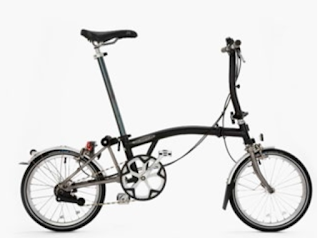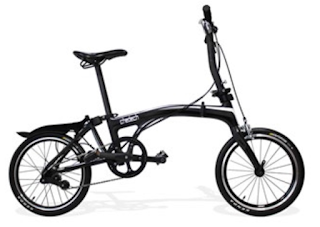CJEU rules that functional shapes are eligible for copyright protection, in so far as they are original works
The Court of Justice of the European Union (CJEU) has issued its judgment in Brompton Bicycle, C-833/18, ruling that copyright protection is available to functional shapes, subject to them being original works in the sense clarified by the Court itself in earlier case law.
Background
The judgment originated from a referral for a preliminary ruling made by the Tribunal de l’entreprise de Liège (Belgium) in the context of proceedings that Brompton Bicycle had brought against Korean company Get2Get, claiming infringement of copyright in the shape of its iconic folding bike.
Brompton Bicycle’s bike was originally created in 1975 and has been sold in its current form since 1987:

Source: Opinion of Advocate General Campos Sánchez-Bordona in C-833/18
Get2Get’s product, which is named ‘Chedech’ and allegedly infringes copyright in the Brompton Bicycle’s own bike, is the following:

Source: Opinion of Advocate General Campos Sánchez-Bordona in C-833/18
In response to Brompton Bicycle's claim, Get2Get submitted that the appearance of the claimant’s product would be dictated by the technical function sought and that it would deliberately adopt the folding technique (previously covered by a now expired patent) because that is the most functional method. In turn, Brompton Bicycle submitted that other shapes are present on the market and this would demonstrate the originality of its product: free and creative choices were made in the realization of its bike.
The Belgian court stayed the proceedings and asked the CJEU to clarify whether copyright protection under Directive 2001/29 (the InfoSoc Directive) applies to a product whose shape is, at least in part, necessary to obtain a technical result. To this end, the referring court also asked the CJEU to determine whether any of the following criteria would be relevant to such an assessment:
- The existence of other possible shapes which allow the same technical result to be achieved;
- The effectiveness of the shape in achieving that result;
- The intention of the alleged infringer to achieve that result;
- The existence of an earlier, now expired, patent on the process for achieving the technical result sought.
Today’s decision
In its 39-paragraph ruling, the CJEU held that copyright protection is in principle available to products whose shape is, at least in part, necessary to obtain a technical result, in so far as "that product is an original work resulting from intellectual creation, in that, through that shape, its author expresses his creative ability in an original manner by making free and creative choices in such a way that that shape reflects his personality".
Copyright protection of functional shapes
In achieving this result, the Court reviewed earlier case law and, in line with the holding in its 2019 decision in Cofemel, C-683/17 (commented on DesignWrites here), it confirmed that - for copyright protection to arise - it is "both necessary and sufficient" that the subject matter at hand is original, in the sense that it is its author's own intellectual creation that results from their free and creative choices and reflects their personality.
As the CJEU had held in previous instances, originality is not fulfilled where the realization of a subject matter has been exclusively dictated by technical considerations, rules or other constraints which have left no room for creative freedom. Also considering the principle according to which copyright only protects the expression of ideas rather than ideas per se (idea/expression dichotomy), the Court ruled that:
a subject matter satisfying the condition of originality may be eligible for copyright protection, even if its realisation has been dictated by technical considerations, provided that its being so dictated has not prevented the author from reflecting his personality in that subject matter, as an expression of free and creative choices.
As regards the shape of the folding bike at issue in the background proceedings, the CJEU noted that it is for the referring court to determine both whether that product is a 'work' (in the sense clarified in Levola Hengelo, C-310/17 – commented here) and whether such shape is exclusively dictated by technical considerations, rules or other constraints, which have left no room for creative freedom.
The other criteria mentioned by the referring court
The referring court had also asked the CJEU to clarify whether, in order to assess whether a shape is necessary to achieve a technical result, account is to be taken of the four specified criteria indicated above.
The CJEU held that the existence of other possible shapes which allow the same technical result to be achieved is "not decisive", and the intention of the alleged infringer to achieve that result is "irrelevant".
Turning to the criteria relating to the effectiveness of the shape in achieving that result and the existence of an earlier, now expired, patent on the process for achieving the technical result sought, the Court concluded that "they should be taken into account only in so far as those factors make it possible to reveal what was taken into consideration in choosing the shape of the product concerned.” Importantly, “in order to assess whether the folding bicycle at issue in the main proceedings is an original creation and is thus protected by copyright, it is for the referring court to take account of all the relevant aspects of the present case, as they existed when that subject matter was designed, irrespective of the factors external to and subsequent to the creation of the product.”
The implications of the decision
Since its seminal ruling Infopaq, C-5/08 nearly 11 years ago, the CJEU has been contributing fundamentally to both shaping and placing the building blocks of copyright protection in the EU. Through a string of decisions, the Court has answered the most basic and relevant question, that is: when does copyright protection arise?Today, the CJEU has issued yet another ruling contributing to this very debate. The Brompton Bicycle decision appears in line with earlier case law of the CJEU itself and builds upon the most recent ruling in this field (Cofemel, C-683/17).
Two aspects in particular stand out.
First, compared to the Opinion of the Advocate General in the same case, the CJEU inter alia rejected the proposal – made therein – to take into account, not the intention of the infringer, but rather the intention of the author. Overall, if the subject-matter at issue is a work, to determine copyright protection, originality is the only requirement that needs to be satisfied. The CJEU, however, did not go into detail of clarifying how the assessment of originality is to be conducted, e.g., by indicating what specific criteria (if any) need to be positively taken into account. Instead, the Court limited its response to the consideration of the criteria proposed by the referring court.
Secondly, in line with Cofemel, C-683/17 and - in the trade mark field - the recent judgment in Gömböc, C-237/19 - the decision does not adopt a necessarily restrictive approach to the potential cumulation of intellectual property rights (IPRs). As the Court recalled in the latter case, each right has its own subsistence requirements and the analysis required to determine eligibility for a certain type of right is different from that under other rights. In today's Brompton Bicycle ruling, the Court pointed out that, to determine copyright subsistence, account is only to be taken of the relevant requirements under this right, "as they existed when that subject matter was designed, irrespective of the factors external to and subsequent to the creation of the product", including earlier protection under other IPRs.
Bird & Bird represented Brompton Bicycle. The team was led by partner Benoit Van Asbroeck, who was assisted by associates Guillaume de Villegas and Auriane Schockaert. For PR enquiries please contact Emma Lago.



